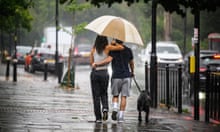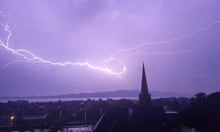Heavy rain and thunderstorms could cause “dangerous” flooding this week in cities and rural areas across the UK, forecasters have warned.
The Met Office has issued a yellow thunderstorm warning for most of the UK on Monday and Tuesday with the possibility of flash flooding, disruption to transport and power cuts.
The weather warning will stay in place for southern England on Wednesday, where communities could be cut off by flooded roads and the chance of fast-flowing or deep flood water could cause “danger to life”.
The warning follows weeks of little rain, which combined with extreme heat exacerbated by climate breakdown has caused droughts across parts of the UK.
The National Drought Group on Friday moved parts of the south-west, parts of southern and central England, and the east of England into official drought status.
Welsh Water, Southern Water and South East Water have already imposed hosepipe restrictions, Yorkshire Water’s ban will start on 26 August, while South West Water will introduce a ban for Cornwall and parts of Devon on 23 August, and Thames Water said it was planning one in the coming weeks.
The Met Office spokesperson Stephen Dixon said thunderstorms and heavy rain were likely to hit more localised areas in Scotland, as well as areas of the south-west and east of England, with the potential of up to 50mm of rainfall within three hours in some places.
He added: “That being said, it is quite hard to pinpoint exactly where these thunderstorms will crop up. Some areas will miss the showers completely but where they do come down, there could be some impacts like surface water flooding, with the rain obviously hitting dry land, travel disruption and power cuts affecting homes and businesses.”
Grahame Madge, another spokesperson for the Met Office, told the Daily Telegraph: “If people know that properties may have flooded before it might be the time just to be ready – have a clear-up, put any valuables at a higher level. It could be as simple and as fundamental as that, so that if you do have to move quickly you are already halfway prepared.”
South West Water announced its hosepipe ban on Monday, the first in 26 years. The Devon and Cornwall region has had little rain for the past eight months and July was the driest for nearly a century.
Politicians and campaigners have said water company bosses should be stripped of their multimillion-pound bonuses until they fix leaks and build reservoirs.
after newsletter promotion
Prof Hannah Cloke, an expert in hydrology at the University of Reading, said the heavy rain would not ease the drought conditions.
“It’s a drop in the ocean really,” Cloke said. “It is not soaking into the soil which is how we really need it. We need it back into the system where it can be stored. We really need a long winter of rain to replenish this.”
Robert Caudwell, the chair of the Association of Drainage Authorities (Ada), said the industry was concerned about surface water flooding but there was little it could do to help prevent it.
He said: “The problem is that with thunderstorms at this time of the year it’s very difficult to predict exactly where they are, and our members have been holding as much water in their systems as possible to try to prevent things going dry, for the environment and farmers who want to irrigate.
“So the last thing we want to do is what you would normally do if heavy rain was forecast, which is to build a bit more freeboard in by allowing more water to be taken out of the system, which is very difficult when you’re really unsure [which] areas will get a thunderstorm.”








